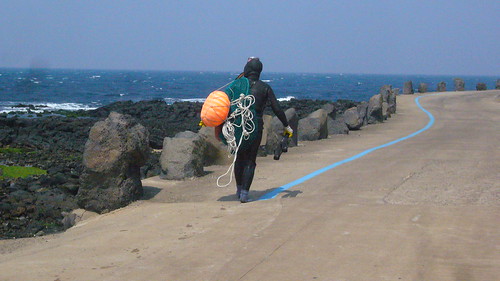Diving Women of Korea - The Haenyeo
Wednesday, August 05, 2009
Jolie Bookspan, M.Ed, PhD, FAWM
The diving women are a respected profession of hard work to gather food for their communities. The work is difficult and cold. The numbers of both Ama and Haenyao are decreasing every year, as the daughters who would take their mother's roles go to other work in the cities.
The first recorded Korean diving (that I know of) is from the 400's A.D. around the Chechu (Jeju) Island area. It is likely that diving had gone on centuries before that. The Haenyao historically dived all year (even in winter), and without assistance of weights or ropes to ascend or descend. They made as many as 30 dives an hour, to depths from 10 to 30 meters, at temperatures in the winter as low as 10 C.
 In the 1960s, many physiologic studies were carried out on the Ama and Haenyao to see what their lung volumes were before and after dives, their temperature regulation and tolerance to cold, their ability to tolerate strenuous work, changes in heart rate and blood distribution during breath hold diving, their physical characteristics compared to non-divers, how alveolar gases (oxygen and carbon dioxide in their body) changed during their breath hold dives, and other interesting topics. Some say that the sudden huge scientific interest was because they dived nearly naked.
In the 1960s, many physiologic studies were carried out on the Ama and Haenyao to see what their lung volumes were before and after dives, their temperature regulation and tolerance to cold, their ability to tolerate strenuous work, changes in heart rate and blood distribution during breath hold diving, their physical characteristics compared to non-divers, how alveolar gases (oxygen and carbon dioxide in their body) changed during their breath hold dives, and other interesting topics. Some say that the sudden huge scientific interest was because they dived nearly naked. Diving clothes varied by geographic area, with some divers wearing only a rope belt or loincloth. No fins were used to help swimming. Later when wet suits were developed, only male divers wore them. Women were prohibited protective suits by their cooperatives, since they were considered more cold tolerant to begin with, and the advantage of the suit would "accelerate over-harvesting" Later, the work became pretty much exclusive to women.
Diving clothes varied by geographic area, with some divers wearing only a rope belt or loincloth. No fins were used to help swimming. Later when wet suits were developed, only male divers wore them. Women were prohibited protective suits by their cooperatives, since they were considered more cold tolerant to begin with, and the advantage of the suit would "accelerate over-harvesting" Later, the work became pretty much exclusive to women.Taking many large breaths before a breath hold extends time because "overbreathing" lowers carbon dioxide in the body. Carbon dioxide signals you to breathe, so it is protective to have it build and make you want to return to the surface before you go unconscious from lack of oxygen. Hyperventilating (too many large breaths) before a dive can cause a drowning accident. The haenyao and ama practice a short hyperventilation with a distinctive whistling maneuver which was studied to find why it may not cause the problems of hyperventilation without the maneuver.
To call them "The haenyao women divers" is redundant. The word haenyao already refers to the female. I asked them what the males were called and the Haenyao laughed at me, saying that males cannot withstand the hard work or the cold, and it is known that women do better in the cold. Dr Suk Ki Hong, one of the best known researchers of immersion and the haenyao and Ama divers wrote, "The shivering threshold is elevated as compared to men, and thus women are distinctly in a better position than men to work in cold water. Undoubtedly there could be many other reasons. However these facts lead us to postulate that men could not compete successfully by virtue of their poor tolerance to cold."
Sadly, Western sport divers started writing articles and presenting lectures at dive conferences in the 1990s, mistakenly claiming women did not have better cold tolerance and had greater risk of cold injury. The myth was repeated in diving magazines, scuba classes, and textbooks of the era.
Are there male indigenous divers? Yes. I will write of them and their stories in the future. Stay tuned.
Link to haenyao museum site
Previously:
- Diving With the Japanese Ama Divers
- Japanese Ama Divers - Cold, Clothing, and Children
- The AmaSan Japanese Diving Women
- The Mermaid Stories
- Living Under The Sea
- Nutrition for Endurance Swim Training
- Hyperbaric and Aquatic Medicine On Travel
- Train Exercise is Exercise Training
- Three Common Swimming and SCUBA Myths in the News Again
- Diver Down Flags - Boating, Swimming, SCUBA Safer and Smarter
- Exercise and Fitness in Decompression Sickness Risk
- Helium Speech - An Astronaut Calls the President of the United States
---
Subscribe to The Fitness Fixer, free. Click "updates via e-mail" (under trumpet) upper right.
Read success stories of Fitness Fixer methods and send your own. See Dr. Bookspan's Books, take a Class, get certified DrBookspan.com/Academy.
---
Read success stories of Fitness Fixer methods and send your own. See Dr. Bookspan's Books, take a Class, get certified DrBookspan.com/Academy.
---
Haenyo image via Wikipedia
Photo 2 by JoopDorresteijn
Image 3 by kozyndan
Labels: breath-hold diving, cold, myths, squat, swimming

![Reblog this post [with Zemanta]](http://img.zemanta.com/reblog_e.png?x-id=52d1f1f2-7e37-46d7-8039-2c70a89fc982)

0 Comments:
Post a Comment
<< Home